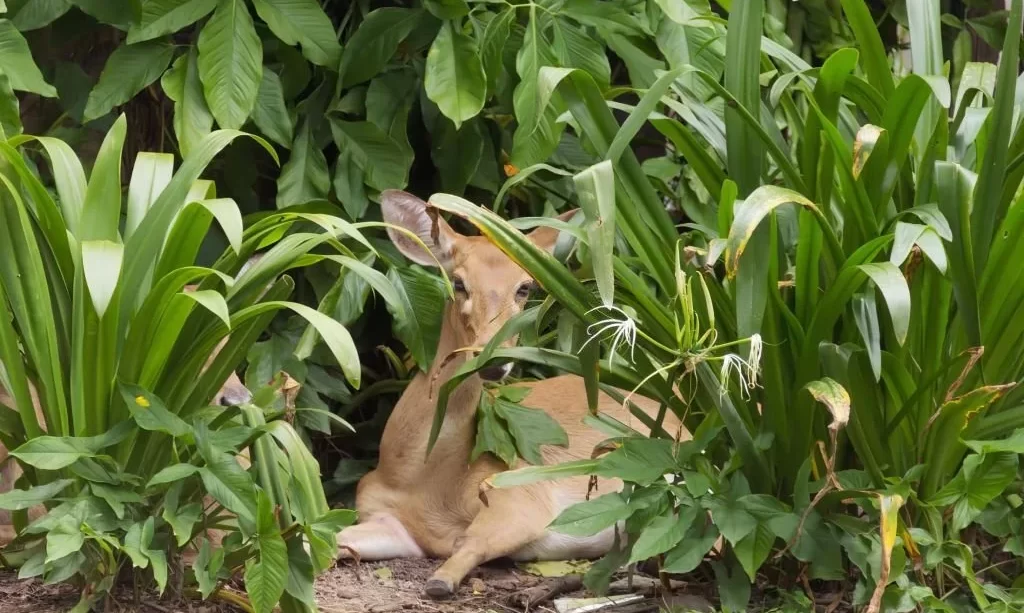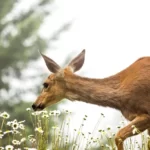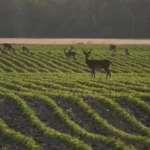Gardens, with their lush greenery and vibrant blooms, can be a haven for both nature enthusiasts and wildlife alike. However, an age-old question often looms over gardeners: Do deer feast on the plants we lovingly cultivate? One plant that frequently piques the curiosity of gardeners is the canna lily. Known for its stunning flowers and tropical flair, canna lilies are prized additions to many gardens. In this article, we embark on a journey to unravel whether these elegant blooms are on the menu for deer. Join us as we explore the fascinating world of canna lilies and the behavior of these gentle herbivores in our gardens.
- HARDINESS ZONE.7-10
- GROW.Soak the seeds in water for 12 to 24 hours.After sowing, lightly cover the seeds, then water the medium.Afterwards, cover the container with clear plastic wrap and place it in a warm location.The temperature should be maintained at 70-75 F.Germination should occur in 7 to 14 days.
- WHEN TO PLANT.April and May
- ATTRACTIVE.Blooms late spring through fall. Sun to part shade, moist soil or at pond-edge. Hummingbirds love it.
- USE.Great for larger patio containers and nice in any mixed border. The tall varieties can be planted closely to create a privacy screen.
About Canna Lilies
Before we delve into the dietary preferences of deer, let’s take a moment to get to know canna lilies a bit better. Canna lilies, scientifically known as Canna indica, are a species of flowering plants native to tropical and subtropical regions. These perennial plants are renowned for their striking appearance, featuring bold, paddle-shaped leaves and eye-catching flowers that come in a spectrum of colors, from fiery reds to sunny yellows. Due to their stunning aesthetics, canna lilies have become popular ornamental plants in gardens worldwide. Gardeners often use them to add a touch of the exotic and vibrant to their outdoor spaces. But do these beautiful blooms also attract the attention of deer?
Deer Behavior and Preferences
To understand whether deer are likely to nibble on canna lilies, it’s essential to grasp some fundamentals of deer behavior in gardens. Deer are herbivores, which means their diet consists primarily of plants. In residential areas, deer may explore gardens in search of food, and their choices are influenced by a combination of factors.
Deer exhibit browsing behavior, meaning they tend to graze on various plants, sampling what’s available in their environment. However, not all plants are equally appealing to them. Deer often have preferences for certain types of plants and may be drawn to those that offer easy access, are highly nutritious, or have a taste they find particularly appealing. Understanding these preferences and behaviors is key to determining whether canna lilies are likely to be on the deer’s menu in your garden.
Do Deer Eat Canna Lilies?
Now, let’s address the central question: Do deer have an appetite for canna lilies? The answer to this question can vary depending on several factors, including regional deer populations and individual deer preferences. In general, canna lilies are not among the top choices for deer when it comes to browsing. These plants have attributes that may make them less appealing to deer.
Canna lilies produce leaves that are relatively tough and fibrous, which can deter deer from feeding on them. Additionally, while the flowers of canna lilies are beautiful, they don’t produce the same level of scent or nectar that some other plants do, making them less likely to attract deer.
However, it’s important to note that in times of scarcity or if other preferred food sources are limited, deer may nibble on canna lilies as a last resort. Therefore, while canna lilies are not typically the first choice for deer, it’s still possible for them to be affected by deer browsing, particularly in areas with high deer populations.
Factors Influencing Deer Feeding
Several factors can influence whether or not deer choose to eat canna lilies in your garden:
- Local Deer Populations: The presence and size of local deer populations play a significant role. In areas with abundant deer, they may be more inclined to explore and potentially sample various plants, including canna lilies.
- Availability of Other Food Sources: If deer have access to a variety of natural food sources, such as native plants or agricultural crops, they may be less likely to target ornamental plants like canna lilies.
- Deterrents: Some gardeners use deer deterrents like scent repellents, fencing, or noise devices to discourage deer from entering their gardens. The presence of these deterrents can significantly reduce the likelihood of deer feeding on canna lilies.
- Deer Preferences: Individual deer have their own preferences when it comes to food. While canna lilies may not be a top choice for many deer, there can be variations in taste among individuals.
Understanding these factors and taking appropriate measures can help you protect your canna lilies and other garden plants from potential deer damage. While deer may not be their primary target, it’s always wise to be prepared, especially in areas where deer are common garden visitors.
Protecting Canna Lilies from Deer
To safeguard your canna lilies from potential deer browsing, you can implement several strategies:
- Deer-Resistant Plants: One effective approach is to surround your canna lilies with plants that are known to be deer-resistant. These include species like lavender, salvia, and rosemary. Deer are less likely to venture into areas with plants they find unpalatable.
- Fencing: Installing deer fencing around your garden can be a highly effective deterrent. Deer fencing should be at least 8 feet tall to prevent deer from jumping over it. Additionally, you can use smaller fencing around individual plants or flower beds.
- Repellents: Scent-based repellents can be applied to your canna lilies to deter deer. These products emit odors that deer find unpleasant. However, they may need to be reapplied periodically, especially after rain.
- Motion-Activated Devices: Motion-activated sprinklers or noise devices can startle deer when they approach, causing them to leave the area. These can be useful for protecting your garden, including canna lilies.
- Garden Design: Consider the layout of your garden. Placing canna lilies closer to your home or near frequently visited areas can make deer less likely to approach. Deer tend to be more cautious when they perceive human activity.
- Repellent Plants: Some plants, like marigolds and chrysanthemums, have natural repellent properties that can deter deer. Planting them alongside your canna lilies may help protect them.
Remember that no method is entirely foolproof, as deer behavior can vary. A combination of these strategies, tailored to your specific garden and local deer population, can provide the best protection for your canna lilies and other cherished plants.
- Tough durable deer netting; Protects landscape and crops from deer and other animals
- Economical, lightweight deer protection; Black UV-resistant deer netting
- Reusable mesh deer fence; Stops deer and other animals from eating shrubs, berries, and vegetables
- Easy to use roll of deer fence netting; Attaches easily to posts and trees
- Do it yourself deer netting for protecting trees, shrubs, orchards and crops
Final Thoughts
In conclusion, while canna lilies are not typically a deer’s first choice for a meal, they can still be vulnerable to browsing, especially in areas with high deer populations or during periods of food scarcity. Understanding deer behavior and preferences is essential for gardeners looking to protect their canna lilies and maintain the beauty of their gardens.
By employing deer-resistant plants, installing fencing, using repellents, and considering your garden design, you can reduce the likelihood of deer damage. Keep in mind that what works best may vary depending on your specific circumstances. With the right precautions and a bit of careful planning, you can enjoy the stunning presence of canna lilies in your garden while coexisting peacefully with the local deer population.





